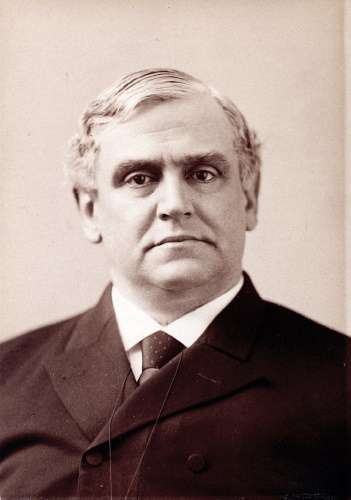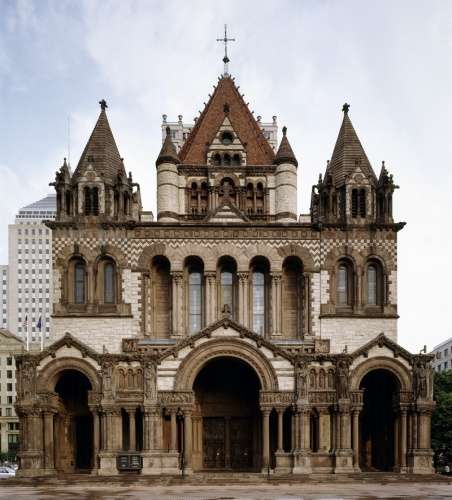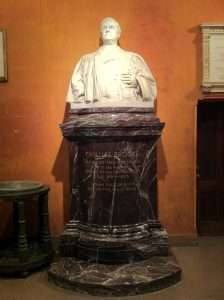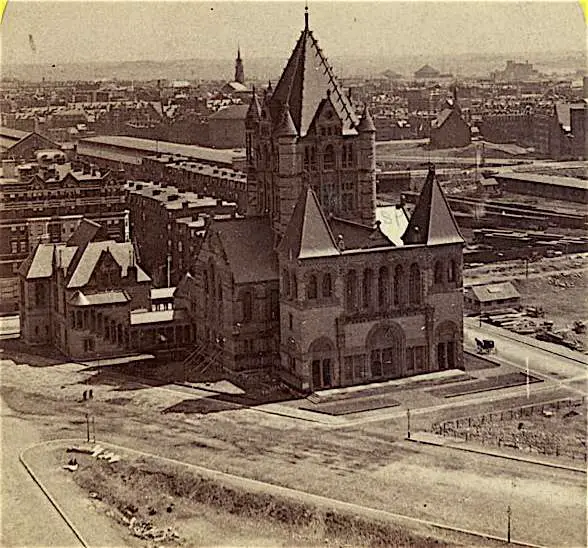Boston’s Trinity Church owes its magnificent appearance to the Episcopal priest who wrote the lyrics to the Christmas carol, O Little Town of Bethlehem — and, of course, to architect Henry Hobson Richardson.
Phillips Brooks (1835-1893) was descended from the Rev. John Cotton on his father’s side and Samuel Phillips, the founder of Phillips Academy in Andover, Mass., on his mother’s. Born in Boston, educated at Harvard and Virginia Theological Seminary, he once wrote his only ambition was to be a parish priest.
In 1869 he became rector of Trinity Church. The Great Boston Fire of 1872 destroyed the parish church on Summer Street, and Brooks began one of the most ambitious building campaigns in America.

Phillips Brooks
Trinity Church
Critics consider Trinity Church an architectural masterpiece, designed by Richardson, muralist John LaFarge and stained glass artists William Morris and Edward Burne-Jones. Finished in 1877, it established Richardson’s reputation. Historian Douglas Shand-Tucci described it as “an American Hagia Sophia.’
The style became known as the Richardsonian Romanesque style, with clay roof, heavy arches, rough stone and a massive tower. Architects adopted the style for a number of public buildings across the United States.

Trinity Church in Boston
Sunday after Sunday, Brooks preached at Trinity Church to large crowds drawn by his inspirational sermons. “Do not pray for easy lives,” he implored his congregation. “Pray to be stronger men.”
He told them, “Character may be manifested in the great moments, but it is made in the small ones.” And he could have been talking about his campaign to build Trinity Church when he said, “Set yourself earnestly to see what you are made to do, and then set yourself earnestly to do it.”
Brooks was consecrated Bishop of Massachusetts in 1891, but only served for 15 months before he died at the age of 57.
O Little Town of Bethlehem

Memorial to Phillips Brooks at Trinity Church. Of statues, Brooks said,, “Life comes before literature, as the material always comes before the work. The hills are full of marble before the world blooms with statues.”
He wrote O Little Town of Bethlehem in 1868, after he visited the city in Palestine three years earlier. His organist, Lewis Redner, put the words to music. Redner recalled how it happened: “As Christmas of 1868 approached, Mr. Brooks told me that he had written a simple little carol for the Christmas Sunday-school service, and he asked me to write the tune to it,” he wrote. “Mr. Brooks came to me on Friday, and said, ‘Redner, have you ground out that music yet to “O Little Town of Bethlehem”? I replied, ‘No,’ but that he should have it by Sunday.
“On the Saturday night previous my brain was all confused about the tune. I thought more about my Sunday-school lesson than I did about the music. But I was roused from sleep late in the night hearing an angel-strain whispering in my ear, and seizing a piece of music paper I jotted down the treble of the tune as we now have it, and on Sunday morning before going to church I filled in the harmony. Neither Mr. Brooks nor I ever thought the carol or the music to it would live beyond that Christmas of 1868.”

Trinity Church Nativity Windows
Buried Like A King
Brooks loved Christmas. “The earth has grown old with its burden of care, but at Christmas it always is young, the heart of the jewel burns lustrous and fair, and its soul full of music breaks the air, when the song of angels is sung,” he wrote.
People called him the greatest preacher of the 19th century. He is credited with strengthening the Episcopal Church, and with introducing Helen Keller to Christianity and to Anne Sullivan.
Phillips Brooks’ death in 1893 was a major event in Boston. He was buried in Mount Auburn Cemetery, where one observer wrote, ‘They buried him like a king.’
The Episcopal Church recognizes the day of his death, January 23, as a feast day.
Photos: Nativity stained glass windows, By Rebecca Kennison – Own work, CC BY 2.5, https://commons.wikimedia.org/w/index.php?curid=1585418; Memorial to Phillips Brooks, By Andrewrabbott – Own work, CC BY-SA 3.0, https://commons.wikimedia.org/w/index.php?curid=18420785

3 comments
[…] Hobson Richardson, of Trinity Church fame in Boston, designed the Brown Thomson building, and Cass Gilbert designed both the Woolworth […]
[…] he rose to eminence as a religious leader, Phillips Brooks (Class of 1855) played the huge Princess Glumdalka, Queen of the Giants, in Tom Thumb. Brooks […]
[…] friend H.H. Richardson commissioned him to paint murals at Trinity Church, but his easel paintings didn’t sell enough to pay the bills. He began to experiment with stained […]
Comments are closed.